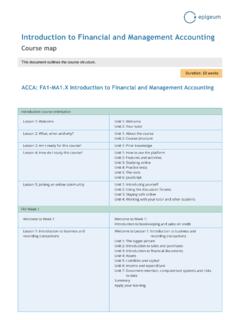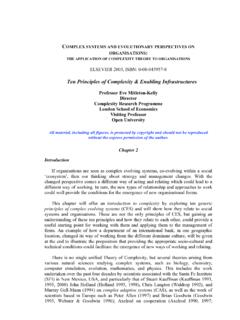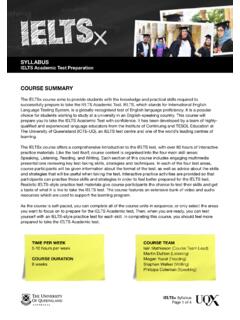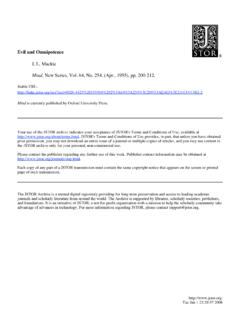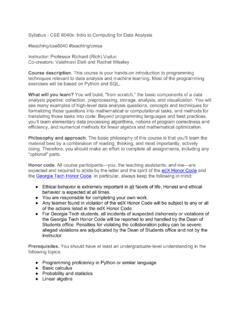Transcription of Azure Virtual Machines Practice Exercises
1 Azure Virtual Machines Practice Exercises Overview This course includes optional practical Exercises where you can try out the techniques demonstrated in the course for yourself. This guide lists the steps for the individual practical Exercises . See the Overview page under Practical Exercises in your course for information about getting started. Azure Setup If you already have a Microsoft Azure subscription, you can skip this section. Otherwise, follow these steps to create a free trial subscription. You will need to provide a valid credit card number for verification, but you will not be charged for Azure services for more information, see the frequently asked questions on the Azure sign-up page.
2 1. If you already have a Microsoft account that has not already been used to sign up for a free Azure trial subscription, you re ready to get started. If not, don t worry, just create a new Microsoft account. 2. After you ve created a Microsoft account, create your free Microsoft Azure account. You ll need to sign-in with your Microsoft account if you re not already signed in. Then you ll need to: Enter your cellphone number and have Microsoft send you a text message to verify your identity. Enter the code you have been sent to verify it. Provide valid payment details. This is required for verification purposes only your credit card won t be charged for any services you use during the trial period, and the account is automatically deactivated at the end of the trial period unless you explicitly decide to keep it active.
3 PowerShell Setup Before you begin, make sure that your lab computer has a minimum of PowerShell 4 installed. You can install the latest version of the management framework (including PowerShell ) by downloading and installing the Windows Management Framework software. You can download it from Once you verify that your computer has the minimum required version of PowerShell, you can proceed to download the necessary modules: 1. From your lab computer, open an elevated PowerShell prompt. 2. Verify Azure related modules are available. If Azure modules are not available proceed with the following steps. Get-Module -All 3.
4 Install the AzureRM module for resource management. Install-Module AzureRM 4. If you get prompted to install and import the NuGet provider, Type Y and then press the Enter key. 5. If you are notified that the repository is untrusted, confirm that you want to install the modules by typing Y and then pressing the Enter key. The installation process will take several minutes as packages are downloaded and installed. 6. After the download and installation is finished, import the module. Import-Module AzureRM 7. Install the Azure module for service management. Install-Module Azure command. 8. If you are notified that the repository is untrusted, confirm that you want to install the modules by typing Y and then pressing the Enter key.
5 The installation process will take several minutes as packages are downloaded and installed. 9. Once the download and installation is finished, import the module. Import-Module Azure command. 10. Verify Azure related modules are available. Get-Module -All If you have trouble installing the PowerShell modules from the PowerShell gallery, you can try the WebPI method instead. Visit to download and install the modules. Deploy a New Virtual machine (Resource Manager) In this exercise you will create a new Virtual machine with a Resource Manager deployment model. 1. Navigate to the new Azure Portal at and sign in.
6 2. On the Hub menu, click New. 3. On the New blade, search for Server 2012 R2. 4. In the search results, click Windows Server 2012 R2 Datacenter. 5. In the Everything blade, click Windows Server 2012 R2 Datacenter. 6. On the Windows Server 2012 R2 Datacenter blade, notice the default deployment model is set to Resource Manager. Click Create. 7. On the Create Virtual machine blade, fill in the following values for basic settings (substituting your information for the user name, subscription, and location) and click OK. Name: SERVER-01 VM disk type: HDD User name: <Your first name> Password: Pa$$w0rd12345 Subscription: <Your subscription> Resource group: Create a new one named Server2012R2-template Location: <Your location> 8.
7 On the Choose a size blade, click View all. Click the A0 Basic size and then click Select. 9. On the Settings blade, review the default options for storage, network, extensions, high availability, and monitoring. Click OK. 10. On the Summary blade, review the configuration and then click OK. 11. When the VM creation finishes, click Virtual Machines in the left pane. 12. In the Virtual Machines blade, click the server name for the VM that you deployed. 13. In the Server-01 blade, click Stop at the top of the blade to stop the VM. This ensures that you don t consume resources unnecessarily. Create Windows Server 2012 R2 VM (PowerShell) In this exercise , you will deploy a new Virtual machine using PowerShell.
8 1. Open an elevated PowerShell prompt. 2. Authenticate with your Azure administrative credentials. Add-AzureAccount 3. Obtain the subscription name. Make a note of the name. Get-AzureSubscription 4. Select the subscription. Select-AzureSubscription -SubscriptionName "<SubscriptionName>" -Current 5. Create the storage account. The storage account name must be unique. You must use a lower case name that only contains letters, not numbers or symbols. For the location, you can opt to use a location closer to you. New-AzureStorageAccount -StorageAccountName <Name> -Location West US 6. Setup the subscription where <SubscriptionName> is the name of your subscription and <CurrentStorageAccountName> is the name of your storage account from the previous step.
9 Set-AzureSubscription -SubscriptionName "<SubscriptionName>" -CurrentStorageAccountName "<CurrentStorageAccountName>" 7. Acquire the image name for the newest image of Windows Server 2012 R2 Datacenter. Copy the image name (ImageName) to a text file. Get-AzureVMImage | where {$ -eq "Windows Server 2012 R2 Datacenter" | sort PublishedDate -Descending } | select -Last 1 | Select PublishedDate,ImageFamily,ImageName | FL 8. Specify a unique name for the service. For the location, you can use West US or a location closer to you. You should use the same location that you did when you created the new storage account.
10 New-AzureService -ServiceName <Name> -Location West US 9. Create the VM. Replace <ImageName> and <ServiceName> with your instance. New-AzureVMConfig -Name "Server15" -InstanceSize ExtraSmall -ImageName <ImageName> | Add-AzureProvisioningConfig Windows - AdminUsername "<YourName>" Password " " | New-AzureVM -ServiceName "<ServiceName>" Add a Disk to a Windows Server 2012 R2 VM (PowerShell) In this lab exercise , you will use PowerShell to add a new (empty) data disk to your VM. 1. Open an elevated PowerShell prompt. Consider using the ISE. 2. Add a new 10GB data disk. Get-AzureVM "<ServiceName>" -Name "<VMName>" | Add-AzureDataDisk -CreateNew -DiskSizeInGB 10 -DiskLabel "Data" -LUN 0 | Update-AzureVM 3.


